Winchester
Explore hidden histories, historic photos, and things you never knew about Winchester from the collections and archives of Historic England.
Discover your local listed buildings and places
Introducing some of Winchester's most historic sites, included in the National Heritage List for England. Some of these captions have been summarised by AI. Click through for the official List entry. Skip this section and go to place by numbers
Stratton Park
Micheldever
Stratton Park, originally laid out by Sir Francis Baring in the early 19th century, incorporates aspects of Humphry Repton's designs and features historical gardens from the late 17th...
Lainston House
Sparsholt
Lainston House is a historic country house and formal garden from the 17th century, with significant ties to historical figures like John Evelyn and Gertrude Jekyll.
Cranbury Park
Hursley
Cranbury Park features 18th-century formal gardens, pleasure grounds, and a landscape park with historic buildings. Its design includes works by George Dance the Younger and J B Papworth.
The King's Royal Rifle Corps War Memorial, Winchester
Winchester
War memorial. Erected 1922, after the First World War, to the design of the sculptor John Tweed with an inscription added after the Second World War.
Cathedral Church of the Holy Trinity
Winchester
The Cathedral Church of the Holy Trinity, built with Isle of Wight stone, features a remodelled nave and notable Perpendicular recasing, overseen by historic figures like Bishop Edington.
The Grange
Northington
The Grange, a Greek Revival country house in Hampshire, was transformed by William Wilkins in the early 19th century for Henry Drummond. It's a Scheduled Ancient Monument.
Horse and Rider sculpture, High Street, Winchester
Winchester
Horse and rider sculpture of 1983. Read the official list entry to find out more.
Hospital of St Cross and Almshouses of Noble Poverty
Winchester
Founded in 1136 by Henry de Blois, the Hospital of St Cross features Norman architecture with C19 restorations and is renowned for its picturesque buildings and historic significance.
Warnford Park
Warnford
Warnford Park, featuring a mid-18th-century landscape possibly designed by Lancelot Brown, was a setting for a country house, now demolished, with remaining pleasure grounds.
Avington Park
Itchen Valley
Avington Park has origins in medieval times and the 17th century, with major developments in the 18th century by the third Duke of Chandos.
The Grange, Northington
Itchen Stoke and Ovington
The Grange in Northington, an 18th-century park, features a neoclassical house designed by C R Cockerell. It has ties to historical figures like Sir Robert Henley and Alexander Baring.
Winchester Castle
Winchester
The upstanding and/or buried remains of part of the Roman defences, part of the Roman and early medieval city, medieval Winchester Castle, and the C17 royal palace known as the 'King's...
Battle of Cheriton 1644
Bishops Sutton
The Battle of Cheriton in 1644 saw Royalist forces under Sir Ralph Hopton defeated by Sir William Waller's Parliamentarians, altering the Royalist strategy and securing Hampshire for...
Winchester Quaker Meeting House
Winchester
Quaker Meeting House built in around 1773. Read the official list entry to find out more.
Church of St Andrew
Chilcomb
The Church of St Andrew in Chilcomb, built around 1120-40, features Norman architecture with later modifications. Notable for its historical monuments and C15 encaustic tiles.
New Place Shirrell Heath
Shedfield
New Place Shirrell Heath, a 1906 Jacobean-style country house by Lutyens, features reused 1630s Bristol woodwork, showcasing a shift from Arts and Crafts to classical style.
The Hampshire, Isle of Wight and Winchester War Memorial
Winchester
First World War memorial designed by Sir Herbert Baker FRIBA RA, unveiled 1921, with later additions for the Second World War. Read the official list entry to find out more.
Cheriton War Memorial
Cheriton
First World War memorial, unveiled on 17 October 1920, with further names added after the Second World War. Read the official list entry to find out more.
Hyde Abbey Gateway
Winchester
Hyde Abbey Gateway is a significant 15th-century structure made of flint, featuring a large carriage arch, located in King Alfred Place.
Cheyney Court
Winchester
Cheyney Court, adjacent to the south entrance gate to The Close, features 15th and 16th-century architecture with stone ground floors and timber-framed upper levels.
Church of the Holy Trinity
Winchester
1853-5 by Henry Woodyer. Read the official list entry to find out more.
Avington House
Itchen Valley
Avington House is a significant late 16th-century country house with additions in the late 17th and 18th centuries, featuring classical architectural elements and rich interior decorations.
St John's Rooms and Chapel
Winchester
St John's Rooms and Chapel features a 13th-century flint and stone chapel with lancet windows, and 18th-century stuccoed upper floors with sash windows and decorative elements.
Wolvesey Palace
Winchester
The upstanding and/or buried remains of part of the Roman civitas capital of Venta Belgarum, part of the city wall, and the early medieval, medieval and late C17 bishops' palaces of...
Wolvesey Palace
Winchester
Wolvesey Palace is a Bishop's residence built in 1684 by Sir Christopher Wren for Bishop George Morley, featuring ashlar stonework and distinctive architectural elements including a stone...
Fromond's Chantry St Marys College
Winchester
Fromond's Chantry in St Mary's College was established in the 15th century by John Fromond and features a chapel and library.
College Hall St Mary's College
Winchester
St Mary's College, College Hall, built in the late 14th century, features a historic hall and schoolroom, with notable 16th-century panelling.
Outer Court With Outer Gate St Mary's College
Winchester
Late 14th-century two-storey Outer Gate at St Mary's College features a four-centred arch, Brew house, and 1663 stable court.
Garden Wall to the South of Minster House on the East and…
Winchester
The 18th-century garden wall, constructed with stone, flint, and brick, enhances the cohesive historic ensemble of buildings on Great Minster Street.
10, The Close
Winchester
10, The Close features a 13th-century vaulted undercroft and panelled room above, set within an 18th and 19th-century exterior.
Trafalgar House
Winchester
A C18 town house extended in the C19, altered in the C20 and remodelled internally in the 1970s by Donald Insall and Associates.
Kingsgate the Church of St Swithun Upon Kingsgate
Winchester
Kingsgate and the Church of St Swithun upon Kingsgate is a 14th-century gateway, a significant historic monument, with a 16th-century church built above it.
Part of the City, Palace and Castle Wall Running East Fro…
Winchester
The 13th-century City, Palace, and Castle Wall are fragmentary but traceable, with 15th-century repairs. Limestone rubble, shared by historic sites, includes Westgate and Kingsgate.
Pilgrims' Hall
Winchester
Pilgrims' Hall, from the 13th-14th century, features a significant early hammer beam roof, widely recognized as an important architectural structure.
The Deanery, Incorporating Prior's Hall
Winchester
The Deanery, incorporating Prior's Hall, features 14th-15th century elements, Tudor stone structures, and a 17th-century central part. It underwent significant restoration in 1971.
1, The Close
Winchester
1, The Close, dated to 1699, is a red brick structure with blue headers, featuring two-storey wings and a central pediment. It is part of a listed building group.
Close Boundary Walls and Gates Priors Gate
Winchester
The Close boundary walls and Prior's Gate, dating back to the 13th and 15th centuries, feature limestone rubble with a four-centred arch and original doors.
Explore more
Search for more listed placesWinchester through time
This timeline shows the first period of use for buildings and places on the National Heritage List for England, just one of the details recorded for every list entry. Click around to see how Winchester changes over time. Skip this section and go to aerial photos
Prehistoric Before AD 43
Prehistory covers a million years of human occupation before the Roman invasion and the introduction of writing. Primarily hunter-gatherers of several human species including Neanderthals, the peoples moved across Europe, hunting animals, exchanging ideas and developing complex culture and belief systems including burial rites and astronomical understanding, as at Stonehenge for example.
Roman AD 43 to AD 410
Britain was invaded by four legions of the Roman army in AD 43, who relatively rapidly conquered England from landing points in Kent. Parts of Wales and Scotland soon followed.
Roman culture brought urbanism, monumental buildings, wide-ranging religious beliefs, writing, and strong social hierarchy. The Roman administrative system was withdrawn in AD 410.
Early medieval AD 410 to AD 1066
This period, often associated in England with Anglo-Saxons and Vikings, saw a reduction in urban living from the Roman period and increased migration from northern Europe.
Traces of this period can be found in cemeteries, particularly in artefacts and in some of the very early churches, as this period also saw the growth of Christianity in Britain.
Medieval AD 1066 to AD 1540
This period, sometimes known as the Middle Ages, began with the Norman invasion in AD 1066. It saw a significant rise in military and defensive buildings such as castles and earthworks, as well as religious houses dominating a largely agricultural landscape.
The monarchy and Church dominated the period, which also saw the break with the Roman Catholic Church and the English reformation.
Post medieval AD 1540 to AD 1901
The Post-Medieval period brought seismic changes to life in England, with religious reformation leading to the democratization of worship and the destruction of hundreds of religious houses.
In parallel, there was a huge expansion of scientific study and enlightenment that permanently altered the nation's social structure and landscape. Industrialization and mass production lead to wider global trade, emigration, and immigration.
20th century AD 1901 to AD 2000
The 20th century saw an incredible expansion of England's transport networks, with suburban growth shadowing rapid infrastructural expansion. The establishment of state schools, hospitals, and modern technical colleges, with new architectural styles, radically changed the appearance of towns and cities.
Two catastrophic world wars and the 1918 pandemic also brought unprecedented change, altering England's built environment and social structures forever.
Prehistoric Before AD 43
Prehistory covers a million years of human occupation before the Roman invasion and the introduction of writing. Primarily hunter-gatherers of several human species including Neanderthals, the peoples moved across Europe, hunting animals, exchanging ideas and developing complex culture and belief systems including burial rites and astronomical understanding, as at Stonehenge for example.
Roman AD 43 to AD 410
Britain was invaded by four legions of the Roman army in AD 43, who relatively rapidly conquered England from landing points in Kent. Parts of Wales and Scotland soon followed.
Roman culture brought urbanism, monumental buildings, wide-ranging religious beliefs, writing, and strong social hierarchy. The Roman administrative system was withdrawn in AD 410.
Early medieval AD 410 to AD 1066
This period, often associated in England with Anglo-Saxons and Vikings, saw a reduction in urban living from the Roman period and increased migration from northern Europe.
Traces of this period can be found in cemeteries, particularly in artefacts and in some of the very early churches, as this period also saw the growth of Christianity in Britain.
Medieval AD 1066 to AD 1540
This period, sometimes known as the Middle Ages, began with the Norman invasion in AD 1066. It saw a significant rise in military and defensive buildings such as castles and earthworks, as well as religious houses dominating a largely agricultural landscape.
The monarchy and Church dominated the period, which also saw the break with the Roman Catholic Church and the English reformation.
Post medieval AD 1540 to AD 1901
The Post-Medieval period brought seismic changes to life in England, with religious reformation leading to the democratization of worship and the destruction of hundreds of religious houses.
In parallel, there was a huge expansion of scientific study and enlightenment that permanently altered the nation's social structure and landscape. Industrialization and mass production lead to wider global trade, emigration, and immigration.
20th century AD 1901 to AD 2000
The 20th century saw an incredible expansion of England's transport networks, with suburban growth shadowing rapid infrastructural expansion. The establishment of state schools, hospitals, and modern technical colleges, with new architectural styles, radically changed the appearance of towns and cities.
Two catastrophic world wars and the 1918 pandemic also brought unprecedented change, altering England's built environment and social structures forever.
Aerial photos of Winchester
Aerial photography helps reveal secrets of England's changing landscapes that are impossible to see from the ground. Skip this section and go to archive images
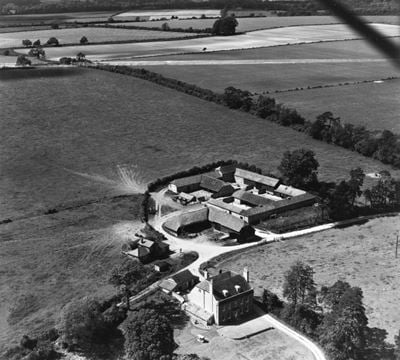
Old Alresford
Manor Farm, Old Alresford, 1951
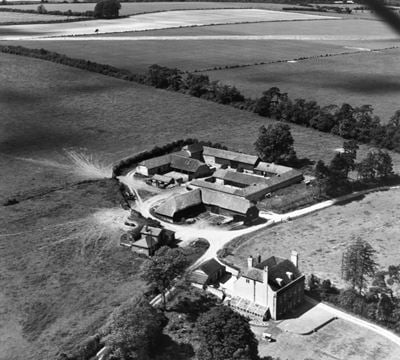
Old Alresford
Manor Farm, Old Alresford, 1951

Bramdean
Woodcote Manor House, Bramdean, 1938

Bramdean
Woodcote Manor House, Bramdean, 1938
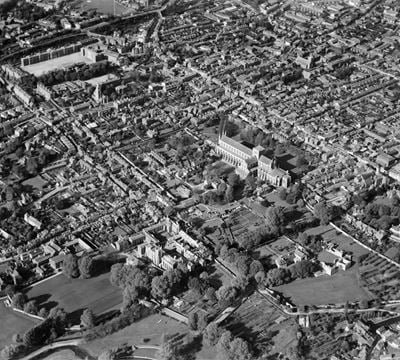
Winchester
General view of the city centre, Winchester, 1920
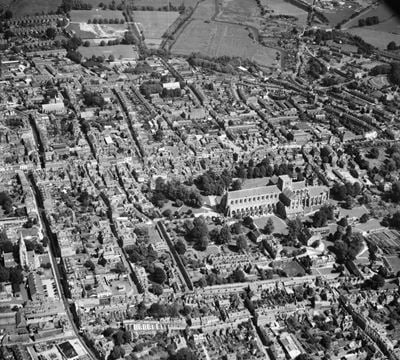
Winchester
The Cathedral of the Holy Trinity and city centre, Winchester, 1953
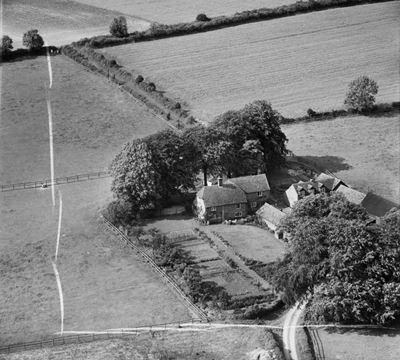
Bishop'S Waltham
Bishop's Down Farm, Bishop's Waltham, 1952

Bishop'S Waltham
Bishop's Down Farm, Bishop's Waltham, 1952
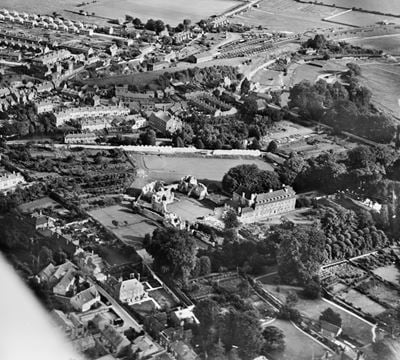
Winchester
Wolvesey Palace and environs, Winchester, 1928

Winchester
Wolvesey Castle and the surrounding city, Winchester, 1953
Winchester in the Historic England Archive
The Historic England Archive cares for over 15 million images, dating from the 1850s to the present day. Discover stunning images of Winchester's past. Skip this section and go to stories about heritage
Charles George Harper Collection
Winchester, Hampshire
Date created: 1892 - 1933
The east elevation of Marwell Hall
John Gay Collection: Counties
Winchester, Hampshire
Date created: 1975
A view through a brick window of the ambulatory, of the courtyard to almshouses at the Hospital of St. Cross, Winchester.
John Laing Collection
Hampshire
Date created: Oct 1974
View of a concrete train constructing a section of the M27 motorway
London, Midland and Scottish Railway Company
Winchester, Hampshire
Date created: Jul 1906
The front elevation of 8 College Street, formerly the residence of Jane Austen
Nigel Temple Collection of Postcards of Parks and Gardens
Winchester, Hampshire
Date created: 1904 - 1909
GENERAL VIEW
Charles George Harper Collection
Winchester, Winchester, Hampshire
Date created: 1892 - 1933
Looking across the water meadows towards the Chapel of St Cross
John Gay Collection: Counties
Winchester, Hampshire
Date created: 1975
The courtyard and 14th century almshouses at St. Cross Hospital, Winchester. The porch on the right leads to the kitchen and Bretherens Hall.
London, Midland and Scottish Railway Company
The Close, Winchester, Hampshire
Date created: Jul 1906
A view looking through the Priory Gate at Cheyney Court
Nigel Temple Collection of Postcards of Parks and Gardens
Winchester, Hampshire
Date created: 1900 - 1908
A view of the Abbey gardens which are on the site of the medieval St Mary's Abbey
Charles George Harper Collection
Winchester, Hampshire
Date created: 1892 - 1933
A traveller receiving the 'Wayfarer's Dole' from the porter in the porter's lodge at the Hospital of St Cross
John Gay Collection: Counties
Winchester, Hampshire
Date created: 1975
A view through an arched doorway, of the courtyard and 14th century almshouses at the Hospital of St. Cross, Winchester.
London, Midland and Scottish Railway Company
Winchester, Hampshire
Date created: Jul 1906
A view of the south side of Kingsgate with St Swinthun's Church above
Stories about heritage in your local area
Historic England publishes news, blogs, research, videos, and podcasts celebrating England's rich heritage. Discover the stories we have about Winchester. Skip this section and go to education
What Was the Capital of England Before London?
Mentions Cathedral Church of the Holy Trinity, Winchester Cathedral Close
London is England’s capital city now, but when was it founded? And what was the capital of England before London?
The Legend of King Arthur
Mentions Great Hall Winchester Castle
King Arthur was central to the legendary tales of medieval romance. Discover the places connected to Camelot, Tintagel, and the Battle of Badon Hill.
Narrative Structures: England’s Literary History in 11 Places
Mentions 8, College Street
Discover the historic sites in England where famous writers found their inspiration.
The Life and Times of King Alfred the Great
Mentions Statue of Alfred the Great
Explore the story of the Saxon King often credited with being the founder of the English nation.
A Guide to Norman Architecture in England
Mentions Cathedral Church of the Holy Trinity
Norman architecture is a style of medieval architecture built in England following the Norman conquest in 1066.
Empress Matilda and ‘The Anarchy’
Mentions Winchester Castle
A look at the career of 12th century claimant to the English throne the Empress Matilda.
England’s Lost Asylums
Mentions Knowle Hospital, former County Pauper Asylum
Former institutions protected by listing for their architecture or significant contributions to medical science.
A Brief Introduction to Ancient Paths and Highways
Mentions Romano-British enclosure and later hollow ways on Twyford Down
From main roads connecting towns and cities to meandering green lanes and mysterious paths to nowhere, our highways and byways are steeped in history.
Mapping the Palaeolithic in England
Mentions Winchester
Developing a GIS resource to help map the potential for Palaeolithic period archaeology in England.
Emmets Post
Mentions Winchester
An archaeological project part-funded by Historic England revealed intriguing construction details at a Bronze Age barrow on the edge of Dartmoor.
Grant Secures Medieval Castle in Hampshire
Mentions Merdon Castle, Winchester
Work to secure the remains of Merdon Castle near Winchester is now complete.
A Preview of The Sir John Pennycuick Collection for Researchers
Mentions Winchester
The Historic England Archive's Sir John Pennycuick Collection provides a photographic record of streets in early and mid-20th century England.
Historic England Announces New Listings to Celebrate The Queen’s Platinum Jubilee
Mentions Hampshire Archives and Local Studies, Winchester
Listings of places which reflect the important social, technical and cultural changes which have taken place over the 70 years of Her Majesty's reign.
Investing in Scientific Research
Mentions Winchester
How investing in new scientific equipment for Historic England benefits the Historic Environment sector in the UK and internationally.
Heritage Across the Country Benefits from Latest Funding from the Culture Recovery Fund
Mentions Winchester
Over 470 heritage organisations across the country to benefit from the second round of Culture Recovery Fund grants
Captivating Sites Across England Listed During 2020
Mentions Winchester
Highlights from over 400 historic places which have been added to the National Heritage List for England in 2020.
George Clarke announces his top 10 Homes & Gardens in England
Mentions Winchester
George Clarke chooses the homes and gardens which best tell the history of England
Remembering Passchendaele: War Memorials Listed
Mentions The King's Royal Rifle Corps War Memorial, Winchester, Winchester
Battle of Passchendaele centenary marked with 13 new and upgraded war memorial listings
National Collection of Sir Herbert Baker’s War Memorials Recognised
Mentions The Hampshire, Isle of Wight and Winchester War Memorial, The War Cloister, Winchester College, Winchester
15 First World War memorials by Sir Herbert Baker have been listed or upgraded to commemorate the centenary of the Commonwealth War Graves Commission.
25 Years of Archaeological Discovery That Have Rewritten England’s Story
Mentions Winchester
New report illustrating how development-led archaeological discoveries have shed new light on our ancient and recent past.
Winchester's social history through photos
Over 10,000 images from the Historic England Archive have been specially selected and re-captioned for teachers, students, and anyone who wants to learn more about their local area. Skip this section and go to grant-aided places
Wolvesey Castle, Winchester, Hampshire
Period: Medieval (Middle Ages) (1066 - 1484)
Wolvesey Castle was the palace of the Bishops of Winchester. It was built by the bishop Henry de Blois in c1130 - 71.
Wolvesey Castle, Winchester, Hampshire
Winchester, Hampshire
Period: Victorian (1837 - 1901)
Elevated view looking over the rooftops of Winchester from St Giles' Hill, with Winchester Cathedral in the distance.
Winchester, Hampshire
Winchester, Hampshire
Period: Victorian (1837 - 1901)
Elevated view from St Giles' Hill looking across the rooftops of Winchester towards Winchester Cathedral.
Winchester, Hampshire
Westgate, High Street, Winchester, Hampshire
Period: Medieval (Middle Ages) (1066 - 1484)
A view from the south-east looking up the High Street towards West Gate, with a horse and cart outside the shops to the right hand side.
Westgate, High Street, Winchester, Hampshire
Thomas Thetcher Headstone, Winchester Cathedral, Winchester, Hampshire
Period: Georgian (1714 - 1836)
This gravestone, outside Winchester Cathedral, reads: "In Memory of Thomas Thetcher a Grenadier in the North Reg.
Thomas Thetcher Headstone, Winchester Cathedral, Winchester, Hampshire
The Rising Sun, Winchester, Hampshire
Period: Tudor (1485 - 1602)
The front part of this pub dates from c1600. It was restored in the 19th century, but cellars remain from an earlier building.
The Rising Sun, Winchester, Hampshire
The Picture House, High Street, Winchester, Hampshire
Period: 1930s (1930 - 1938)
This image shows an exterior view of The Picture House, taken on the High Street in 1936.
The Picture House, High Street, Winchester, Hampshire
The Forge, Duke Street, The Crease, Micheldever, Hampshire
Period: Georgian (1714 - 1836)
This 18th-century forge is still in full working condition.
The Forge, Duke Street, The Crease, Micheldever, Hampshire
Discover more
Ready for more local heritage? Take a look at these other places nearby


